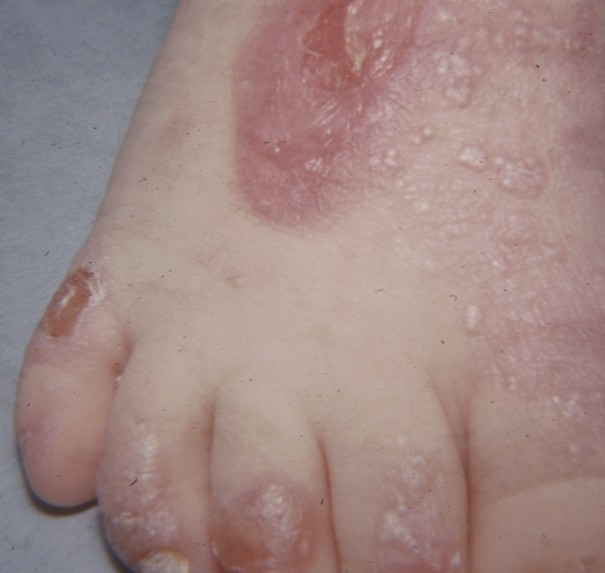Epidermolysis Bullosa (EB)
 Epidermolysis bullosa (EB) is a group of rare, genetic skin diseases in which the skin grows very fragile and begins to easily blister. The skin fragility may be noticed at birth or soon after when a delicate back rub or a hug or a change of diaper is enough to injure the skin, resulting in blistering or open wounds.
Epidermolysis bullosa (EB) is a group of rare, genetic skin diseases in which the skin grows very fragile and begins to easily blister. The skin fragility may be noticed at birth or soon after when a delicate back rub or a hug or a change of diaper is enough to injure the skin, resulting in blistering or open wounds.
Some infants may develop painful blisters in the wet linings of the throat, mouth, stomach, and intestines because of the friction caused when they swallow food or have a bowel movement.
The disease manifestation can vary across children. A mild form of EB can be managed by taking precautions that help to avoid injury. In severely affected children, EB becomes a disability that requires round the clock medical care.
Texas Surgical Dermatology, led by board certified dermatologist Dr. Tri H. Nguyen, provides advanced skin care treatments to patients in Houston, Katy, Spring, The Woodlands, Texas, and surrounding locations.
What are the Types of Epidermolysis Bullosa (EB)?
There are 4 main types of EB which can be distinguished based on their symptoms. These include:
Epidermolysis Bullosa Simplex (EBS)
This is the mildest type which is also the most common. Blisters appear on only the hands and feet of the newborn and the blistering may cease as the child grows. By teenage or young adulthood, the skin of the individual’s palms and soles turns hard and thickened. In some patients, the EBS is more severe with blisters occurring on any part of the skin and even within the mouth.
Dystrophic Epidermolysis Bullosa (DEB)
In a mild case of this dermatology condition, the child shows the presence of blisters only on the hands, elbows, knees, and feet.
In more severe cases, blistering is widespread, and results in patches from where the skin is entirely missing. Blisters within the mouth and esophagus make it painful to swallow food, and the baby will require a feeding tube.
Junctional Epidermolysis Bullosa (JEB)
A mild case of JEB manifests as blisters only on the elbows, hands, knees, and feet of the newborn, and may reduce by the time the baby is around 3 months of age.
In severe cases of JEB, blisters begin to develop in the digestive tract or on larger parts of the body. When these blisters start healing and scars begin to appear, the fingers or toes may get joined together. Such children may also develop breathing problems, infections, and hair loss.
Babies with a very severe form of JEB often do not survive beyond the first year of life.
Kindler Syndrome
This is one of the rarest forms of EB. Soon after birth, the baby’s skin begins to blister and shows extreme sensitivity to the sun. These effects reduce as the child grows but a new condition called poikiloderma appears in its place, causing patches of skin to grow dark. Initially, the darkening occurs only in areas of skin exposed to the sun but after puberty, the effect spreads all over the skin.
Board certified dermatologist Dr. Tri H. Nguyen receives patients from Houston, Katy, Spring, The Woodlands, Texas, and nearby areas for safe and proven skin care procedures.
For More Information contact our Board Certified in Dermatologists at Texas Surgical Dermatology in Spring, TX
For more information on procedures and treatments offered at Texas Surgical Dermatology PA please call 832.663.6566 or click here to contact our dermatologists. Helping patients in Houston, The Woodlands, Spring, Katy and other surrounding areas of Texas.

